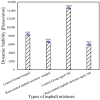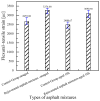Study on the Rheological Optimization and Multiscale Verification of the Asphalt Rejuvenator
- PMID: 40649413
- PMCID: PMC12250891
- DOI: 10.3390/ma18132925
Study on the Rheological Optimization and Multiscale Verification of the Asphalt Rejuvenator
Abstract
The use of Reclaimed Asphalt Pavement (RAP) is a sustainable strategy to conserve natural resources, reduce environmental pollution, and lower construction costs. However, aged asphalt in RAP suffers from oxidation and loss of light fractions, increasing stiffness and brittleness. A key scientific challenge is how to effectively restore the performance of aged asphalt while maintaining cost efficiency. In this study, a novel asphalt rejuvenator was developed to address this issue. The rejuvenator consists of 6% aromatic oil-like materials to replenish light components, 1.52% plasticizer to enhance ductility, and 0.3% modifier A to improve adhesion, with a total dosage of 7.82% by the mass of the aged binder. The rejuvenator meets the requirements of Chinese specifications. The performance evaluation was conducted at both asphalt binder and mixture scales. The results show that the rejuvenator significantly improves low-temperature cracking resistance and medium-temperature fatigue performance of aged binders, although it slightly reduces high-temperature rutting resistance. When applied to asphalt mixtures with 45% RAP, the rejuvenated mixtures exhibited enhanced low-temperature performance. A comparative analysis with commercial rejuvenators confirmed the developed product's competitive performance and economic benefit. This study provides technical insight into rejuvenator design and addresses critical challenges in RAP recycling for sustainable pavement engineering.
Keywords: RAP (recycled asphalt pavement); oil-like materials of aromatic hydrocarbons; rejuvenator; road performance.
Conflict of interest statement
Authors Shanglin Song, Haihong Zhang and Hongbin Chen were employed by the company Gansu Provincial Transportation Research Institute Group Co., Ltd. Author Shanglin Song was employed by the company Scientific Observation and Research Base of Transport Industry of Long Term Performance of Highway Infrastructure in Northwest Cold and Arid Regions. Author Zhen Wang was employed by the company Beijing Municipal Road and Bridge Building Materials Group Co., Ltd. Author Fukui Zhang was employed by the company Gansu Provincial Highway Development Group Co., Ltd. The remaining authors declare that the research was conducted in the absence of any commercial or financial relationships that could be construed as a potential conflict of interest.
Figures
























Similar articles
-
Experimental Study on RAP with High Recycling Content Based on High-Modulus Asphalt Mixture.Materials (Basel). 2025 Jun 16;18(12):2835. doi: 10.3390/ma18122835. Materials (Basel). 2025. PMID: 40572965 Free PMC article.
-
Viability of using high reclaimed asphalt pavement (RAP) contents incorporating waste materials for eco-friendly paving applications: a systematic review.Environ Sci Pollut Res Int. 2025 Jun;32(26):15493-15517. doi: 10.1007/s11356-025-36614-x. Epub 2025 Jun 19. Environ Sci Pollut Res Int. 2025. PMID: 40537705 Review.
-
Performance and mechanism of waste engine oil in the regeneration of aged asphalt from different perspectives.PLoS One. 2025 Jul 24;20(7):e0329203. doi: 10.1371/journal.pone.0329203. eCollection 2025. PLoS One. 2025. PMID: 40705811 Free PMC article.
-
Study of factors affecting the blend of virgin and aged asphalt binder based on molecular dynamics simulation.PLoS One. 2025 Aug 12;20(8):e0328441. doi: 10.1371/journal.pone.0328441. eCollection 2025. PLoS One. 2025. PMID: 40794756 Free PMC article.
-
A systematic review on sustainable utilization of plastic waste in asphalt: assessing environmental and health impact, performance, and economic viability.Environ Sci Pollut Res Int. 2024 Nov;31(54):62676-62701. doi: 10.1007/s11356-024-35395-z. Epub 2024 Nov 2. Environ Sci Pollut Res Int. 2024. PMID: 39487917
References
-
- Mohd Hasan M.R., You Z. Estimation of cumulative energy demand and green house gas emissions of ethanol foamed WMA using life cycle assessment analysis. Constr. Build. Mater. 2015;93:1117–1124. doi: 10.1016/j.conbuildmat.2015.05.029. - DOI
-
- Guo M., Liang M., Du X. Evaluation on Feasibility of Carbon Black and Hindered Amine Light Stabilizer as UV-Resistant Additives of Asphalt Binder. J. Test. Eval. 2023;51:3987–4003. doi: 10.1520/JTE20220611. - DOI
-
- Guo M., Yin X., Du X., Tan Y. Effect of aging, testing temperature and relative humidity on adhesion between asphalt binder and mineral aggregate. Constr. Build. Mater. 2023;363:129775. doi: 10.1016/j.conbuildmat.2022.129775. - DOI
-
- Cong P., Luo W., Xu P., Zhao H. Investigation on recycling of SBS modified asphalt binders containing fresh asphalt and rejuvenating agents. Constr. Build. Mater. 2015;91:225–231. doi: 10.1016/j.conbuildmat.2015.05.041. - DOI
-
- Chen A., Liu G., Zhao Y., Li J., Pan Y., Zhou J. Research on the aging and rejuvenation mechanisms of asphalt using atomic force microscopy. Constr. Build. Mater. 2018;167:177–184. doi: 10.1016/j.conbuildmat.2018.02.008. - DOI
Grants and funding
LinkOut - more resources
Full Text Sources

